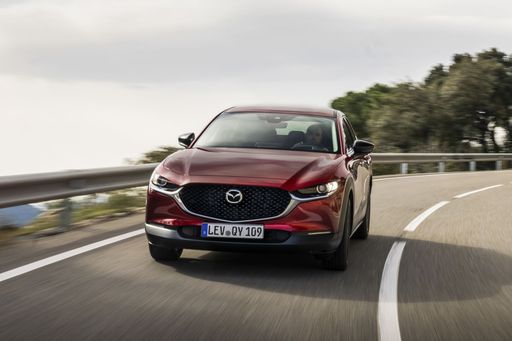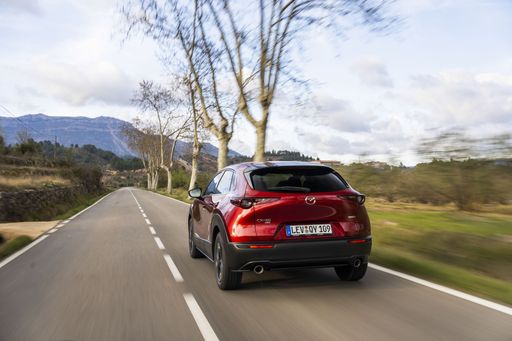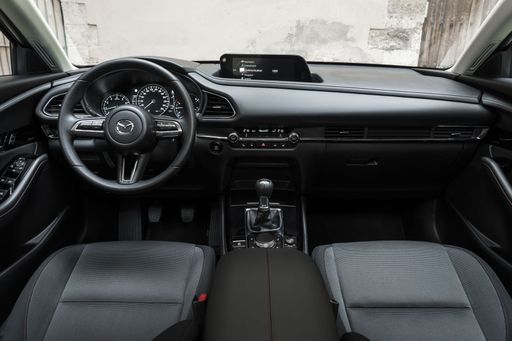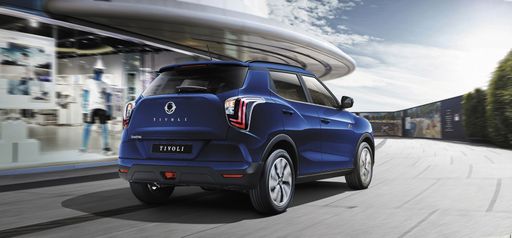Mazda MX-30 VS SsangYong Tivoli – Specs, Efficiency & Price Comparison
Which model is the better choice – the Mazda MX-30 or the SsangYong Tivoli? We compare performance (170 HP vs 163 HP), boot capacity (350 L vs 720 L), efficiency (17.50 kWh vs 7 L), and of course, the price (30800 £ vs 21400 £).
Find out now which car fits your needs better!
The Mazda MX-30 ({ body-type_1}) is powered by a Electric or Plugin Hybrid engine and comes with a Automatic transmission. In comparison, the SsangYong Tivoli (SUV) features a Petrol engine and a Manuel or Automatic gearbox.
When it comes to boot capacity, the Mazda MX-30 offers 350 L, while the SsangYong Tivoli provides 720 L – depending on what matters most to you. If you’re looking for more power, you’ll need to decide whether the 170 HP of the Mazda MX-30 or the 163 HP of the SsangYong Tivoli suits your needs better.
There are also differences in efficiency: 17.50 kWh vs 7 L. In terms of price, the Mazda MX-30 starts at 30800 £, while the SsangYong Tivoli is available from 21400 £.
Compare all the key specs now and find out which model fits your lifestyle best!
Mazda MX-30
The Mazda MX-30 is a compact crossover that combines unique design with an environmentally conscious approach. Its distinct exterior features a coupe-like silhouette and freestyle doors that offer practicality and style. Inside, the cabin boasts sustainable materials, creating a harmonious blend of modern aesthetics and eco-friendly innovation.
details @ de.mazda-press.com
@ de.mazda-press.com
 @ de.mazda-press.com
@ de.mazda-press.com
 @ de.mazda-press.com
@ de.mazda-press.com
 @ de.mazda-press.com
@ de.mazda-press.com
SsangYong Tivoli
The SsangYong Tivoli is a compact SUV that seamlessly blends style with practicality, making it an appealing choice for urban drivers. Its sleek design is complemented by a well-crafted interior, offering a comfortable and spacious experience for passengers. With its reliable performance and modern features, the Tivoli stands out as a versatile option in the competitive compact SUV market.
details @ Ssangyong
@ Ssangyong
 @ Ssangyong
@ Ssangyong
 @ Ssangyong
@ Ssangyong

|

|
|
|
|
Costs and Consumption |
|
|---|---|
|
Price
30800 - 38600 £
|
Price
21400 - 30300 £
|
|
Consumption L/100km
-
|
Consumption L/100km
7 - 8.3 L
|
|
Consumption kWh/100km
17.5 - 18.3 kWh
|
Consumption kWh/100km
-
|
|
Electric Range
85 - 200 km
|
Electric Range
-
|
|
Battery Capacity
32 kWh
|
Battery Capacity
-
|
|
co2
0 - 22 g/km
|
co2
161 - 191 g/km
|
|
Fuel tank capacity
-
|
Fuel tank capacity
50 L
|
Dimensions and Body |
|
|---|---|
|
Body Type
SUV
|
Body Type
SUV
|
|
Seats
5
|
Seats
5
|
|
Doors
5
|
Doors
5
|
|
Curb weight
1720 - 1853 kg
|
Curb weight
1375 - 1492 kg
|
|
Trunk capacity
332 - 350 L
|
Trunk capacity
395 - 720 L
|
|
Length
4395 mm
|
Length
4225 - 4480 mm
|
|
Width
1848 mm
|
Width
1810 mm
|
|
Height
1555 - 1560 mm
|
Height
1613 - 1646 mm
|
|
Payload
398 - 402 kg
|
Payload
425 - 455 kg
|
Engine and Performance |
|
|---|---|
|
Engine Type
Electric, Plugin Hybrid
|
Engine Type
Petrol
|
|
Transmission
Automatic
|
Transmission
Manuel, Automatic
|
|
Transmission Detail
Reduction Gearbox
|
Transmission Detail
Manual Gearbox, Automatic Gearbox
|
|
Drive Type
Front-Wheel Drive
|
Drive Type
Front-Wheel Drive, All-Wheel Drive
|
|
Power HP
145 - 170 HP
|
Power HP
163 HP
|
|
Acceleration 0-100km/h
9.1 - 9.7 s
|
Acceleration 0-100km/h
-
|
|
Max Speed
140 km/h
|
Max Speed
175 - 181 km/h
|
|
Torque
271 Nm
|
Torque
260 - 280 Nm
|
|
Number of Cylinders
-
|
Number of Cylinders
4
|
|
Power kW
107 - 125 kW
|
Power kW
120 kW
|
|
Engine capacity
830 cm3
|
Engine capacity
1497 cm3
|
General |
|
|---|---|
|
Model Year
2022 - 2025
|
Model Year
2021 - 2024
|
|
CO2 Efficiency Class
A, B
|
CO2 Efficiency Class
F, G
|
|
Brand
Mazda
|
Brand
SsangYong
|
Mazda MX-30
The Electric Revolution: Mazda MX-30
The Mazda MX-30 represents a bold leap into the realm of sustainable mobility, bringing a distinct blend of style, efficiency, and innovation. As Mazda's first all-electric vehicle, the MX-30 is designed to capture the hearts of eco-conscious drivers while delivering the fun driving experience the brand is known for. Let’s delve into what makes this vehicle stand out in the increasingly crowded electric vehicle market.
Sleek Design Meets Practicality
The MX-30 is a compact SUV that exudes a modern aesthetic with its clean lines and contemporary silhouette. Measuring 4,395 mm in length and 1,848 mm in width, the MX-30 is designed to navigate city streets with ease. Its unique freestyle doors facilitate easy access to the front and rear seats, accommodating up to five passengers comfortably.
Advanced Electric Powertrain
At the heart of the MX-30 is Mazda's e-SKYACTIV drivetrain, available in both fully electric and plug-in hybrid variants. The electric version delivers a respectable 145 PS (107 kW), whereas the plug-in hybrid offers an enhanced 170 PS (125 kW). Both versions employ front-wheel drive with a single-speed reduction gearbox, ensuring a smooth and responsive ride.
Efficiency and Range
The MX-30 showcases commendable efficiency with a power consumption ranging from 17.5 to 17.9 kWh per 100 km. Drivers can expect a maximum electric range of 200 km for the fully electric model, while the plug-in hybrid offers 85 km on electric power alone. This ensures the MX-30 is well-suited for both daily commutes and extended journeys.
Elegant Interiors and Cutting-Edge Technology
Inside, the MX-30 presents a zen-like cabin featuring sustainable materials like cork and recycled fabrics, reinforcing Mazda’s commitment to environmental consciousness. The vehicle comes equipped with a host of technological advancements, including a digital dashboard and a user-friendly infotainment system that keeps drivers connected and informed on the go.
Performance and Handling
Mazda's dedication to driving pleasure continues with the MX-30. With an acceleration time from 0-100 km/h between 9.1 to 9.7 seconds and a top speed of 140 km/h, it promises an engaging drive. The low centre of gravity, courtesy of the battery placement, and its precise steering ensure the MX-30 feels agile and responsive, whether navigating urban environments or open roads.
Safety and Features
Safety is paramount in the MX-30, which boasts an array of advanced features, including collision avoidance systems and a reinforced body structure. It also scores well on CO2-efficiency, rated between Class A and B, making it a responsible choice for eco-minded consumers.
Conclusion: Mazda MX-30 – A Vision of the Future
In conclusion, the Mazda MX-30 is a testament to the brand's innovative spirit and commitment to sustainability. With its combination of striking design, efficient powertrains, and cutting-edge technology, the MX-30 is a formidable competitor in the electric vehicle market. Offering a blend of sophistication and performance, it is poised to win over motorists who seek an environmentally friendly vehicle without compromising on driving joy.
SsangYong Tivoli
Discover the SsangYong Tivoli: A Blend of Comfort and Performance
In the realm of compact SUVs, the SsangYong Tivoli has carved out a niche for itself with its blend of robust performance and luxurious comfort. Catering to a diverse range of drivers, the Tivoli stands as a testament to SsangYong's commitment to innovation, efficiency, and style. This article dives into the technical brilliance and innovations that make the Tivoli a standout choice in its segment.
Performance Unleashed: Under the Bonnet of the Tivoli
The SsangYong Tivoli does not shy away from showcasing its engineering prowess. With a powerful 1.5 GDI-T petrol engine under its bonnet, the Tivoli offers a thrilling 163 PS (120 kW), ensuring a spirited drive. This engine is paired with either a manual or automatic transmission, providing drivers with options to match their driving preferences.
The Tivoli's performance metrics are equally impressive, boasting a torque range between 260 and 280 Nm. These figures translate to a responsive and dynamic driving experience, whether you're navigating city streets or cruising on highways. Top speeds range from 175 to 181 km/h, underscoring the Tivoli's versatility as a daily driver with an adventurous side.
Efficient on the Roads: Fuel Economy and CO2 Emissions
Efficiency is a hallmark of the Tivoli, with fuel consumption figures ranging between 7 and 8.3 L/100km, depending on the chosen configuration. It's not just about performance; the Tivoli strikes a balance by ensuring environmental considerations are met, with CO2 emissions between 161 and 191 g/km, placing it in the CO2 efficiency classes of F and G.
Innovative and Spacious Design
Designed with the modern driver in mind, the Tivoli combines functionality with style. Its exterior dimensions—spanning a length of 4225 to 4480 mm—create a commanding presence on the road, while its height of 1613 to 1646 mm and width of 1810 mm suggest ample interior space. With a boot space offering 395 to 720 litres, the Tivoli caters to both urban living and adventurous getaways.
Comfort Meets Technology: Inside the Tivoli
The interior of the Tivoli is a reflection of SsangYong's dedication to comfort and technology. Accommodating up to five passengers, the Tivoli ensures every ride is a comfortable journey with advanced features and materials. The availability of various trim levels, such as the Amber, Blackline, and Quartz, allows for personalisation, meeting the specific needs and desires of each driver.
The Tivoli's Commitment to Safety
Safety remains a priority for SsangYong, and the Tivoli is no exception. Equipped with a range of safety features, including a reinforced body structure, multiple airbags, and advanced driver assistance systems, the Tivoli ensures peace of mind for all occupants.
Conclusion
The SsangYong Tivoli is more than just a compact SUV; it is a symbol of outstanding engineering fused with everyday practicality. Whether it's the daily commute or a weekend getaway, the Tivoli is equipped to handle a variety of driving scenarios with style and efficiency. For those seeking a vehicle that combines reliability with cutting-edge technology, the Tivoli stands as a noteworthy contender in the SUV market.
The prices and data displayed are estimates based on German list prices and may vary by country. This information is not legally binding.
